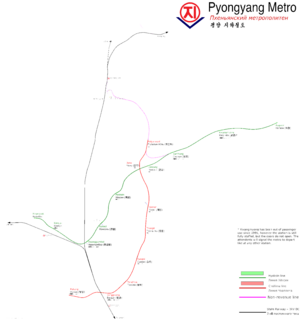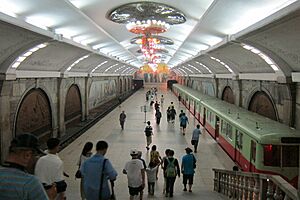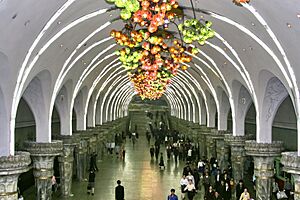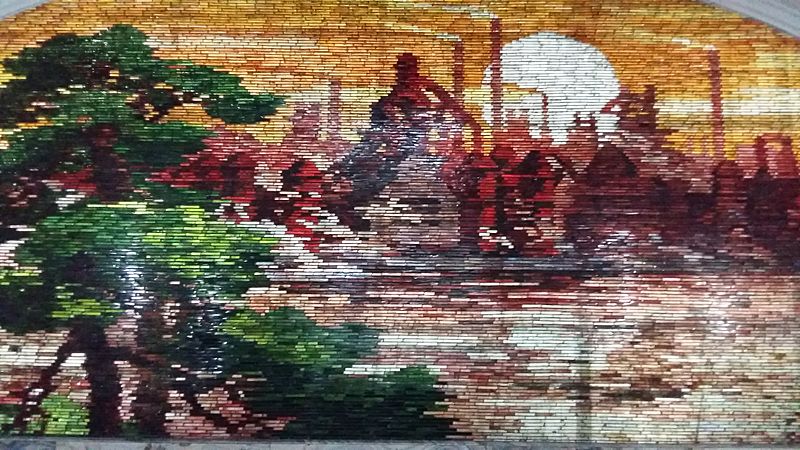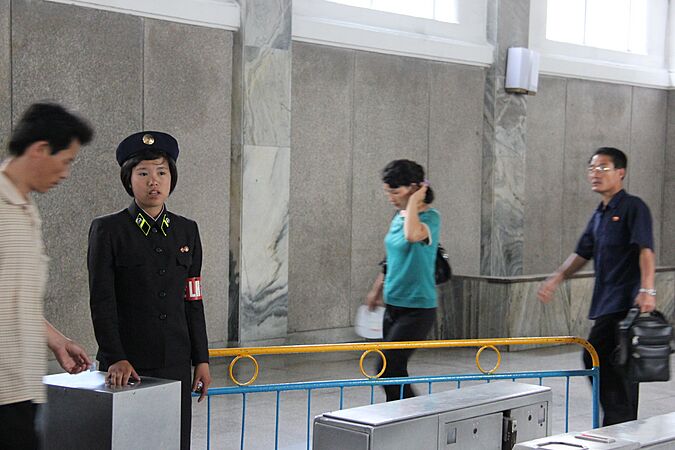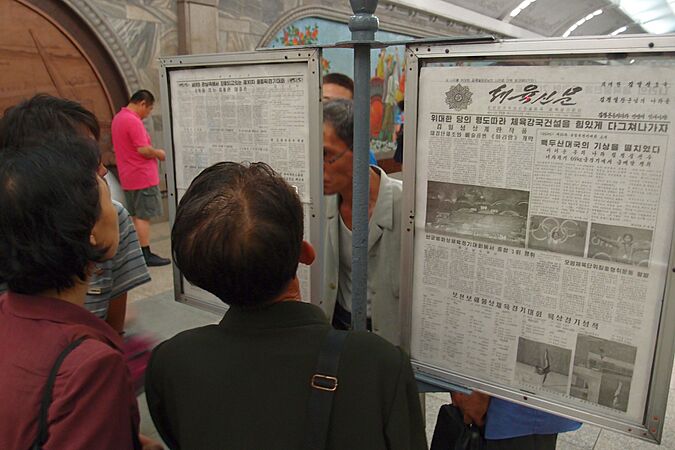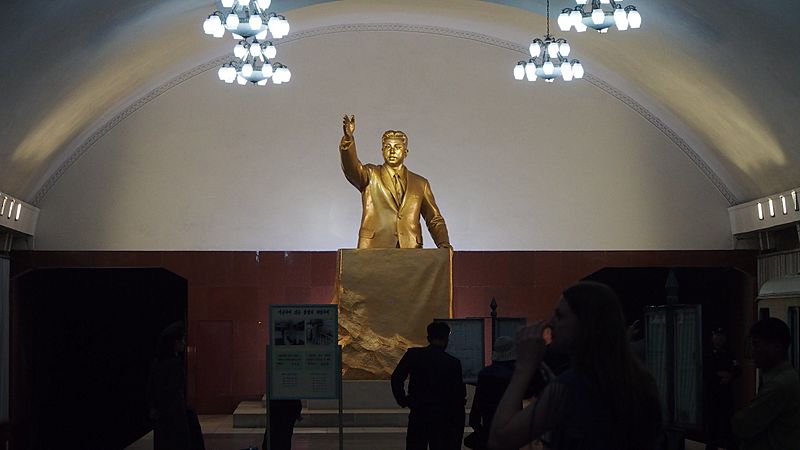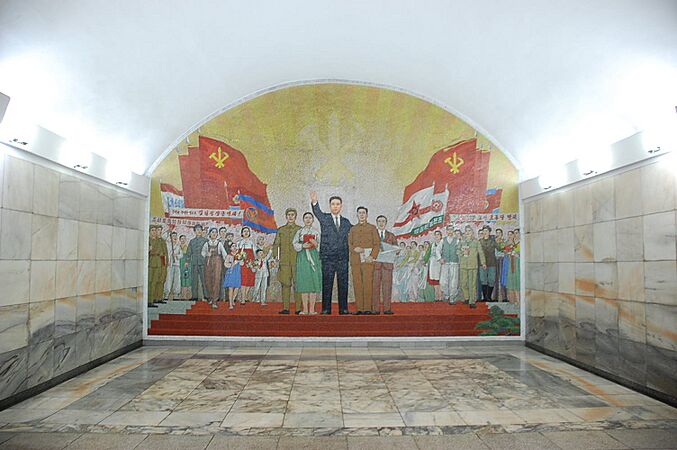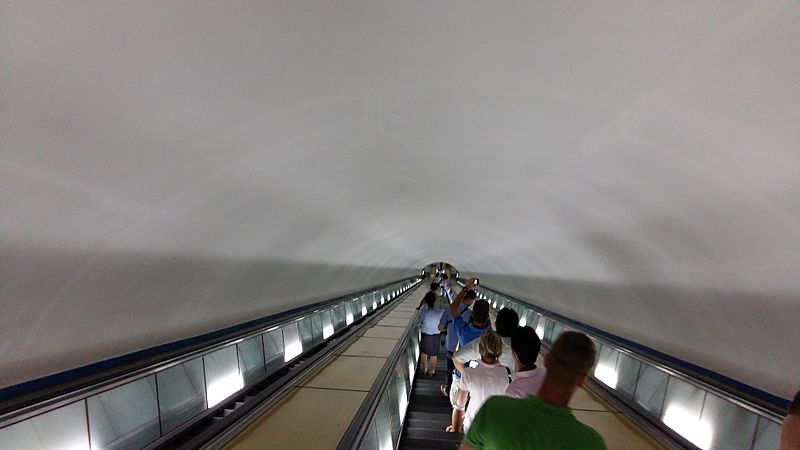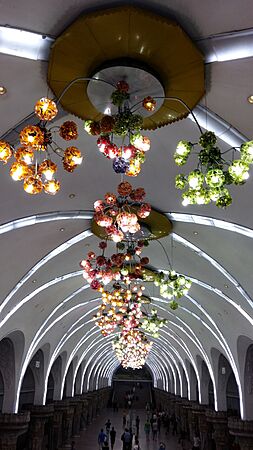Pyongyang Metro facts for kids
Quick facts for kids Pyongyang Metro |
|||
|---|---|---|---|
 Pyongyang subway train.jpg |
|||
| Info | |||
| Locale | |||
| Transit type | Rapid transit | ||
| Number of lines | 2 | ||
| Number of stations | 16 (Chollima Line : 8, Hyoksin Line : 8) | ||
| Daily ridership | 400,000 (Weekdays) 700,000 (Holidays) (July 2019) |
||
| Headquarters | Pyongyang Metro, City Metro Unit, Railway Section, Transport and Communication Commission, Pyongyang, Democratic People's Republic of Korea |
||
| Operation | |||
| Began operation | September 1973 | ||
| Operator(s) | Pyongyang Metro Administration Bureau | ||
| Number of vehicles | 224 (Type D : 216, Type 1 : 8) | ||
| Train length | 4 | ||
| Headway | 3 minute (peak) 5 minute (off-peak) |
||
| Technical | |||
| System length | 22.5 km (14.0 mi) | ||
| Track gauge | 1,435 mm (4 ft 8 1⁄2 in) standard gauge | ||
| Top speed | 70 km/h (43 mph) (Type D) | ||
|
|||
| Pyongyang Metro | |
| Chosŏn'gŭl | |
|---|---|
| Hancha | |
| Revised Romanization | Pyeongyang Jihacheoldo |
| McCune–Reischauer | P'yŏngyang Chihach'ŏldo |
The Pyongyang Metro (Korean: 평양 지하철도; MR: P'yŏngyang Chihach'ŏlto) is a rapid transit system in Pyongyang, the capital city of North Korea. It has two main lines: the Chollima Line and the Hyŏksin Line. These lines connect different parts of the city, helping many people travel every day.
The two lines meet at Chŏnu Station. Around 300,000 to 700,000 people use the metro daily. North Korea built the metro, and it first used trains from China. Later, trains from East Germany were brought in. The Pyongyang Metro even has a museum about how it was built and its history.
Contents
Building the Metro
Construction of the metro began in 1965. The first stations opened between 1969 and 1972. Most of the 16 public stations were built in the 1970s. Two grand stations, Puhŭng and Yŏnggwang, were finished later in 1987. There were reports of accidents during construction in the 1970s.
China helped with building the metro. They sent experts to install equipment, including escalators that were 64 meters (210 feet) tall.
Deep Underground Stations
The Pyongyang Metro is one of the deepest in the world. Its tracks are more than 110 meters (360 feet) underground. There are no parts of the metro system that are above ground. Because it is so deep, the stations can also be used as bomb shelters. They have strong blast doors in the hallways.
It takes about three and a half minutes to ride the escalator from the ground down to the platform. The metro is so deep that the temperature on the platform stays around 18°C (64°F) all year. Other deep metro systems include the Saint Petersburg Metro and the Arsenalna station in Kyiv, which is the deepest station at 105.5 meters (346 feet).
Future Plans and Updates
In 1999, there were plans for two new lines, but their progress is unclear. In 2012, new station designs were shown at an architectural festival. In 2018, there were rumors of possible extensions to the metro system. However, state media did not announce anything, possibly due to funding or past construction issues.
Recently, some stations have been modernized. Kaeson station and Tongil Station were updated in 2019. They now have TVs that show when the next train will arrive and brighter lights. Jonu station and Chonsung station were updated in 2020. These TVs can also display a digital version of the Rodong Sinmun newspaper. Leaders have also announced plans to update the metro and build new trains.
How the Metro Works
The Pyongyang Metro is designed for trains to run very often. During busy times, trains can arrive every two minutes. Currently, trains run every 3 minutes during rush hour and every 5 minutes during the rest of the day. The metro operates from 5:30 AM to 11:30 PM.
Riding the Pyongyang Metro is very cheap, costing only five North Korean Won (less than half a US cent) per ticket. In the past, people used aluminum tokens with the metro's emblem. Then, they used paper tickets. Now, the metro uses special contactless cards. These cards show how many trips you have left. Smoking and eating inside the metro are not allowed and can result in a large fine.
The Pyongyang Metro Administration Bureau runs the system. It is not very accessible for people using wheelchairs. This means it can be difficult for people with disabilities to use the metro.
Metro Lines
The Pyongyang Metro has two main lines:
- Chollima Line: This line is named after a winged horse from old Korean stories. It is about 12 kilometers (7.5 miles) long. It opened on September 6, 1973. The stations on this line include Puhung, Yonggwang, Ponghwa, Sŭngni, Tongil, Kaeson, Jonu, and Pulgunbyol.
- Hyŏksin Line: This name means "renewal." It is about 10 kilometers (6.2 miles) long. It started service on October 9, 1975. The stations on this line are Kwangbok, Konguk, Hwanggumbol, Konsol, Hyoksin, Jonsung, Samhung, and Rakwon. The Kwangmyong station is closed and located between Samhung and Rakwon stations.
The two lines are connected by a track near Jonsung station. Many metro stations are named after nearby landmarks. For example, Kaesŏn Station ("Triumph station") is near the Arch of Triumph.
Metro Design and Features
The entire metro network is underground. Its design is similar to metro systems in other communist countries, especially the Moscow Metro. Both metros are very deep (over 100 meters or 330 feet) and have long distances between stations. They also feature Socialist realist art, like murals and statues, in their stations.
Metro staff wear special military-style uniforms. Each station has free toilets for passengers. Stations also play state radio broadcasts and display the Rodong Sinmun newspaper.
The metro stations can act as bomb shelters during wartime, with large steel doors. Some people believe there are secret lines for government use, similar to Moscow's Metro-2.
One station, Kwangmyŏng, has been closed since 1995 because the mausoleum of Kim Il-sung is located there. Trains do not stop at this station.
Metro Trains
When the metro first opened in the 1970s, it used new DK4 passenger cars made in China. Some of these Chinese-made trains can still be seen in other parts of North Korea.
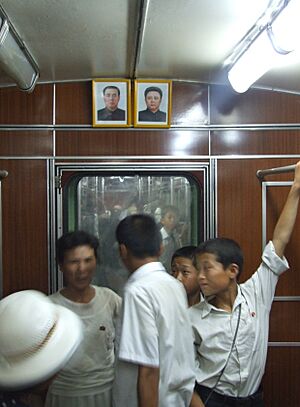
Since 1997, the Pyongyang Metro has mainly used older German trains from the Berlin U-Bahn. These trains were given a new red and cream paint job in Pyongyang. All advertisements were removed and replaced with portraits of leaders, Kim Il Sung and Kim Jong Il. Some older German trains (Class GI) were stopped from underground use in 2001 due to fires. They are now used as commuter trains in other areas.
In 2015, Kim Jong Un rode a new four-car train set. This train was said to be built in North Korea, though it looked like a heavily updated German D-class train. This new train is called 'Underground Electric Vehicle No. 1'. It usually runs on the Chollima Line.
There are ongoing efforts to build new metro cars in North Korea.
Visiting the Metro
In North Korea, tourists usually travel in guided groups and follow specific plans. In the past, foreign tourists could only ride the metro between Puhŭng Station and Yŏnggwang Station. This led to a conspiracy theory that the metro only had these two stops and that the passengers were actors.
However, since 2010, tourists have been allowed to ride the metro at six stations. By 2014, all metro stations were opened to foreigners. Now, tourists on special tours can visit all stations on both lines.
Metro Museum
The Pyongyang Metro has its own museum. A big part of the museum shows how President Kim Il Sung guided the workers building the system. Exhibits include a special vehicle he used to go down into the stations during construction. There is also a railbus he used to ride around the system. The museum also has a map of the planned metro lines.
Gallery
-
A statue of Kim Il Sung at Kaesŏn Station
-
Socialist realist mural at Ponghwa Station
Network Map
See also
 In Spanish: Metro de Pionyang para niños
In Spanish: Metro de Pionyang para niños
- Trams in Pyongyang
- Rail transport in North Korea


